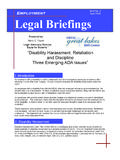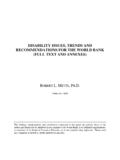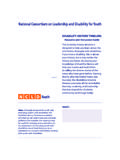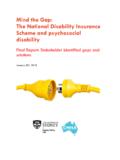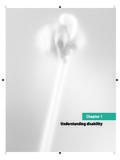Transcription of DISABILITY 101 - University of Hawaii
1 DISABILITY 101: Increasing DISABILITY Awareness and Sensitivity By: Sara Cook, Gaurav Duggal, and Melissa Gibo Edited by Steven E. Brown, and Courtney L. Hatch Center on DISABILITY Studies ( ) University of Hawai i at Manoa Certificate in DISABILITY and Diversity Studies DIS 694, Interdisciplinary Team Development, Fall 2008 Instructor, Steven E. Brown, 1 Preface The DISABILITY 101: Increasing DISABILITY Awareness and Sensitivity curriculum was created as a Community Collaboration Project for an Interdisciplinary Team Development class (DIS 694) in the Certificate in DISABILITY and Diversity Studies Program through the Center on DISABILITY Studies, University of Hawai i at Manoa. The curriculum was designed as an effort to promote inclusive communities where people with disabilities are treated with respect and dignity.
2 We developed this curriculum to give educators a tool to teach youth about DISABILITY issues and raise awareness of how attitudes and language affect how we perceive DISABILITY . DISABILITY 101 was created to provide an introduction to DISABILITY studies, to stimulate interest in DISABILITY issues and provide a mechanism to begin conversations about DISABILITY and inclusion. The curriculum is targeted for use with youth (ages 10-14 years old) but can be modified and adapted to address other target populations. While cultural factors were taken into consideration in the development of the curriculum, all users of DISABILITY 101 should feel free to revise the lesson plans and activities to better suit specific cultural needs. We would like to thank our professor, facilitator, mentor, and editor, Dr.
3 Steven Brown, for his guidance and encouragement in the creation of DISABILITY 101. His high expectations motivated us to develop a sustainable product that addressed our goal of promoting DISABILITY awareness and sensitivity. We would also like to thank the following individuals: Brian Kajiyama, for consenting to have his personal story highlighted in the curriculum and providing the DVD and photographic images used in DISABILITY 101; Jennifer Grant, 9th grade social studies teacher, Farrington High School, for initial implementation of the curriculum and her valuable feedback; Neil Marcus, for providing ideas on how to reach our target audience; and Petra Kuppers, for suggesting we use technology to enhance our communication in the process of the curriculum development.
4 Courtney L. Hatch, for checking web links. All are accurate as of Feb. 27, 2010. We hope you will find DISABILITY 101 a useful introductory tool to DISABILITY Studies. Thank you for your interest in increasing DISABILITY awareness and sensitivity. -Sara Cook, Gaurav Duggal, and Melissa Gibo Authors and Creators of DISABILITY 101 2 DISABILITY 101: Increasing DISABILITY Awareness and Sensitivity Table of Contents Curriculum Lesson 1: Understanding DISABILITY Lesson Pre-Test Rationale School Name Lesson 2: Breaking Down Stereotypes (Part I) Lesson Cerebral Palsy (CP) Definition Who is This Guy? Brian Kajiyama Lesson 3: Breaking Down Stereotypes (Part II) Lesson DISABILITY Definitions Matching Activity DISABILITY Definitions Matching Activity Answer Breaking Down Stereotypes Breaking Down Stereotypes PowerPoint Lesson 4: The Power of Words Lesson Activity Power of Words Lesson 5: People First Language Lesson People First Language People First Language People First Language Exercise Answer People First Sentences People First Sentences Activity Word Post-Test 3 Introduction DISABILITY is universal.
5 As evidenced by global statistics, DISABILITY exists in every culture, in all nations around the world. Although there have been improvements in civil rights for individuals with disabilities in the United States, treatment of people with disabilities continues to be negative in America and elsewhere. To address inequities and discrimination against people with disabilities, a DISABILITY culture has emerged to advocate for equality, inclusion, and social justice and promote DISABILITY awareness and sensitivity. Several disciplines (for example, psychology, sociology, education, medicine, and law) have recognized the importance of addressing DISABILITY issues and have collaboratively created a new discipline, DISABILITY Studies. As a discipline, DISABILITY studies takes an interdisciplinary approach to explore DISABILITY from experiential, historical, and cultural perspectives.
6 DISABILITY studies has helped the DISABILITY movement take strides towards greater equality for people with disabilities. With the emergence of a DISABILITY culture, public perceptions of DISABILITY and attitudes towards people with disabilities have experienced gradual paradigm shifts. It is important we instill in our youth an awareness of DISABILITY and continue to promote sensitivity to DISABILITY issues. Educating youth to understand people with disabilities are people like everyone else can shift negative perceptions of DISABILITY towards acceptance and respect. This curriculum is intended to provide educational tools that promote DISABILITY awareness and sensitivity. We believe if children are given the tools to understand DISABILITY , they will be able to see DISABILITY more positively.
7 In turn, as they become more sensitive and aware of DISABILITY issues, they can then create change in the world around them. As our children are our future, it is within their power to create a society where all people are respected and valued for their unique abilities and strengths. 4 Curriculum Overview This curriculum is intended to promote DISABILITY awareness and sensitivity in youth by developing positive images of people with disabilities. Designed as a five-part lesson series, this curriculum will provide engaging educational tools to increase knowledge about specific disabilities, address DISABILITY stereotypes, and empower students to use positive language in their daily communication. The entire hour curriculum has been broken down into five lessons.
8 Each lesson is formatted for approximately 30 minutes implementation time. The purpose and student learning objectives are included for each lesson to provide an overall idea of the intended outcome. At the completion of the curriculum students should be able to recognize the abilities of people with disabilities, feel comfortable addressing DISABILITY , and use language that creates positive images of people with disabilities. By creating positive impressions of DISABILITY , this curriculum will provide students with tools to break down stereotypes and create more inclusive and respectful learning environments. Although this curriculum is intended for use in middle school and early high school, it may also be used with adults. DISABILITY affects all people of all ages.
9 This curriculum was established to promote DISABILITY awareness and sensitivity for all groups, regardless of age or experience. 5 Lesson 1 Understanding DISABILITY Purpose: To know what it may feel like to have a physical or learning DISABILITY . Lesson Objectives: Students will be able to: Identify their personal feelings and attitudes regarding DISABILITY . Have a basic understanding of what it may feel like to have a physical or learning DISABILITY . Empathize with individuals with disabilities. Materials Needed: Pencil or pen Pre-Test Survey Rationale Handout/Poster Paper (2 sheets) School Name Sample (written backwards) Background (10 minutes): 1. Have students complete Pre-Test Survey. Be sure to give each student an ID number so tests will remain confidential.
10 Be sure to keep a copy of the ID number so students can use the same number for the Lesson 2 Worksheets and Lesson 5 Post-Test. 2. Ask students to think about people they know who have disabilities. 3. Ask students to raise their hand if they know at least one person who has a DISABILITY . 4. Provide students with brief Rationale Handout or post Rationale Poster on the board. Activities (5 minutes): 1. Have students take out two sheets of paper. 2. Have students write the name of their school ( Farrington) with their dominant hand (right hand if right-handed, left hand if left-handed) as many times as they can in 30 seconds. 3. Give student who has written the school name the most times a prize ( candy bar). 4. Have students write the name of their school with their non-dominant hand (left hand if right-handed, right hand if left-handed) as many times as they can in 30 seconds.

